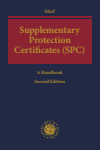Supplementary Protection Certificates (SPC)
Zusammenfassung
Stief
Supplementary Protection Certificates Supplementary protection certificates (SPC) extend the effects of patents for medicinal products by a maximum of five and a half years, i.e. the certificate becomes effective at a time when the respective pharmaceutical is widely known on the market and thus generates the maximum revenue. This explains the enormous economic value of SPCs. They protect some of the most valuable products in the pharmaceutical industry. The legal basis for the SPC for medicinal products is a European Regulation. The obtaining provisions of that Regulation, the scope of protection etc. are highly disputed and have been the subject of numerous decisions of the CJEU. This handbook provides valuable insights into the world of SPCs and the most significant case law and legal sources at EU and national level of Germany, the UK, France, Italy, the Netherlands and Switzerland. The second completely revised edition specifically addresses recent developments of SPCs including manufacturing waivers and the implications of “Brexit”.
Abstract
Stief
Supplementary Protection Certificates Supplementary protection certificates (SPC) extend the effects of patents for medicinal products by a maximum of five and a half years, i.e. the certificate becomes effective at a time when the respective pharmaceutical is widely known on the market and thus generates the maximum revenue. This explains the enormous economic value of SPCs. They protect some of the most valuable products in the pharmaceutical industry. The legal basis for the SPC for medicinal products is a European Regulation. The obtaining provisions of that Regulation, the scope of protection etc. are highly disputed and have been the subject of numerous decisions of the CJEU. This handbook provides valuable insights into the world of SPCs and the most significant case law and legal sources at EU and national level of Germany, the UK, France, Italy, the Netherlands and Switzerland. The second completely revised edition specifically addresses recent developments of SPCs including manufacturing waivers and the implications of “Brexit”.
- Kapitel Ausklappen | EinklappenSeiten
- I–XIV Titelei/Inhaltsverzeichnis I–XIV
- 4–96 Part I: Generals of the Supplementary Protection Certificate in the European Law 4–96
- 4–12 A. Purpose, History and Legal Character of the Certificate 4–12
- I. Overview
- II. Relationship between Grant of the Patent and Authorisation under Pharmaceutical Law
- III. History
- IV. Legal Character
- 13–31 B. Substantive Granting Prerequisites 13–31
- I. General
- II. Product
- III. Basic Patent
- IV. First Marketing Authorisation
- V. No Earlier Certificate – Multiple SPCs for the Same Product
- 32–37 C. Calculation of Term 32–37
- I. General
- II. Relevant Date for the Calculation of Term
- III. Negative Terms
- 38–38 D. Subject Matter 38–38
- 39–41 E. Scope of Protection 39–41
- I. Rights of the Certificate Holder
- II. Limitations and Obligations
- 42–56 F. Specific Practical Problems 42–56
- I. Scope of Protection: “Salt Issue”
- II. First Marketing Authorisation: Use Patents
- III. Substance Combinations
- 57–64 G. Grant Procedure 57–64
- I. General
- II. Application
- III. Grant and Announcement
- IV. Fees to Maintain the SPC
- 65–67 H. Expiry, Invalidity and Revocation 65–67
- I. Reasons for Expiry
- II. Reasons for Invalidity
- III. Revocation of a Term Extension
- IV. Announcement
- 68–68 J. Remedies 68–68
- 69–96 K. Recent Developments 69–96
- I. Intentions to Revise and Amendments to the RegSPC
- II. Calls for the Creation of SPC Regulations for Other Products
- III. Accession of New Member States to the European Union
- IV. Withdrawal of the United Kingdom from the European Union
- 97–184 Part II: Specialities of National Jurisdictions 97–184
- 97–110 L. The SPC in Germany 97–110
- I. National Pharmaceutical and Patent Law
- II. Application of the Art. 3 RegSPC Conditions
- III. Calculation of the Term of the SPC
- IV. Rights, Limitations and Obligations
- V. SPC Grant, Termination and Remedies
- 111–136 M. The SPC in the United Kingdom 111–136
- I. National Law relating to SPCs
- II. Application of the Art. 3 RegSPC Conditions
- III. SPC application procedure
- IV. Transitional Provisions relating to Pre-existing SPCs and Applications from before or during the Transitional Period
- V. Invalidation of SPCs and/or SPC Extensions
- 137–146 N. The SPC in France 137–146
- I. French National Patents and Pharmaceutical Law
- II. The Conditions for Obtaining an SPC
- III. Grant Procedure for SPCs in France
- IV. Scope of Protection
- V. Duration of SPCs
- VI. Waiver of SPCs
- VII. Paediatric Extensions
- 147–155 O. The SPC in Italy 147–155
- I. National Pharmaceutical and Patent Law
- II. SPC Obtaining Provisions and Term
- III. Subject Matter and Scope of Protection
- IV. Rights, Limitations and Obligations
- V. SPC Grant, Termination and Remedies
- 156–164 P. The SPC in The Netherlands 156–164
- I. National Pharmaceutical and Patent Law
- II. SPC Obtaining Provisions and Term in the Dutch Context
- III. Substantive Requirements
- IV. Rights, Limitations and Obligations
- V. License
- VI. Termination and Remedies
- VII. Court Proceedings
- 165–184 Q. The SPC in Switzerland 165–184
- I. Sources of Law and Legislative History
- II. Substantive Granting Prerequisites
- III. Subject-Matter of Protection and Effects
- IV. Term of Protection
- V. SPC for Plant Protection Products
- VI. Application, Fees, Examination and Remedies
- VII. Nullity
- VIII. Swiss Federal Patent Court
- 185–354 Annexes 185–354
- 185–252 A. Selected Decisions of the European and National Case Law 185–252
- A1. Court of Justice of the European Union
- A2. German Courts
- A3. British Courts
- A4. French Courts
- A5. Italian Courts
- A6. Dutch Courts
- A7. Swiss Courts
- 253–354 B. Selected Legal Sources 253–354
- B1. International Treaties
- B2. European Primary Law
- B3. European Regulations
- B4. European Directives
- B5. National Law


